|
|||||||||||||||||||||||||||||||||||||
|
|
Young Diet and healthy lifestyle | ||||||||||||||||||||||||||||||||||||
|
The Resource Centre for adult lifelong education “Essere al Centro” is partner in a project promoted by the Bari Provincial administration about young people’s lifestyles, since the obesity rate of Italian young in their minor age seems to be the second highest rate in Europe. This datum is particularly significant if you consider the more and more widespread use of junk food at a global level, and the decreased use of Mediterranean (and Italian) traditional food and food habits among young population in Italy, worldwide considered the healthiest way of life.
The Provincial project aims to develop in young people the awareness of their own Mediterranean traditions and tastes, and the risks for health of an unbalanced daily diet. One of the initiatives of the project is to promote the use of bread taken as the symbol of good and simple food. Italian traditional bread in many different shapes and tastes, and also bread from other Mediterranean countries will be distributed in the town and in schools to compare flavours and smells. Even the products in the snacks machines will be substituted with fresh bakery products as an experiment to modify young food tastes to healthier ones. “Essere al Centro” therefore planned a sample survey on young people from 15 to 19 years of age to investigate their real tastes and eating habits, to study the phenomenon starting from scientific data. A group of young adults attending a course at the Resource Centre and their teachers prepared a questionnaire and interviewed a sample of 107 young ranging from 15 to 19 years of age about their eating habits. 
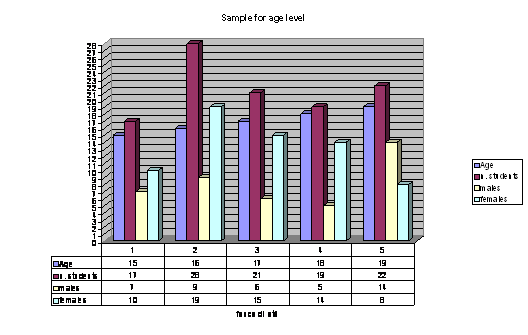
The sample young people come from working class families and middle classes in the Bari area, South of Italy, and still live at home, where Italian traditional habits are still alive, and where mothers usually prepare lunch and dinner at home for the whole family. First of all the young interviewed were asked to express if they preferred sweet taste or salted taste in food, since it seems this is the first thing a dietologist asks when you go for a diet in order to understand your main tastes in food. The results were a little bit out of previsions. You could think young prefer sweet taste, while from the data you can infer there is no great difference between the two in young people’s preference. The different colours stand for the age (blue-15; light violet 16; cream-17; light blue-18; violet-19). 
BREAKFAST Another aspect investigated was if they were used to have breakfast in the morning, since medical advice is to start the day with a good breakfast: 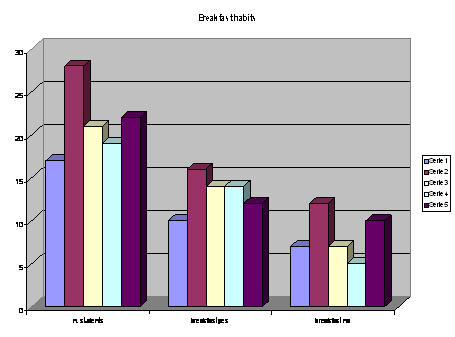
The results show how quite a large number out of the sample do not usually have breakfast at all. This is a first datum to keep into consideration to modify habits towards a healthy diet. Now, considering the ones who normally have breakfast, they investigated about what they consume (beverages and food): 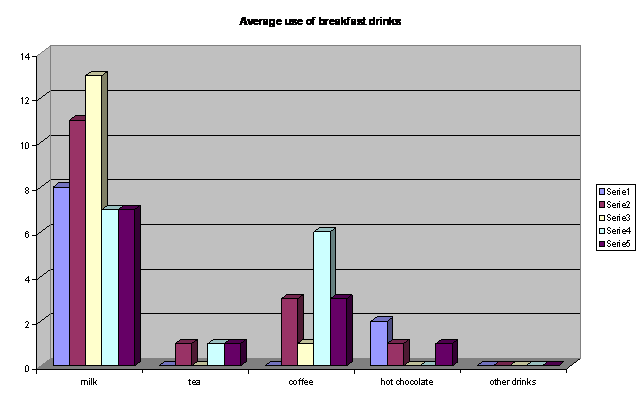
It’s clear how the sample taken uses mainly milk at any age considered, while the use of coffee increases as far as they grow up, especially at the age of 18 (larger use of cappuccino, white coffee and so on). Hot chocolate is also used when still very young (15), but like tea it’s not very popular in taste. 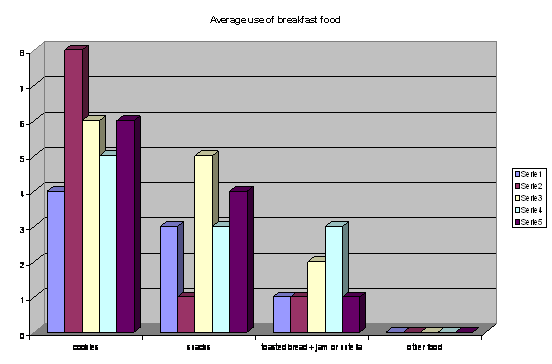
The best-liked food at breakfast are cookies and snacks, while the healthier bread and jam, for example, is not very popular. Another datum to work about. LUNCH The questionnaire distinguished among first course, second course and vegetables. Within each course it provided a choice: 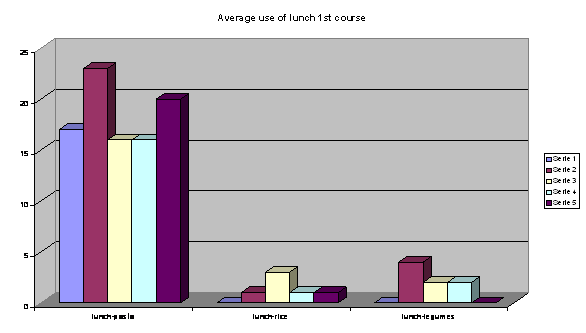
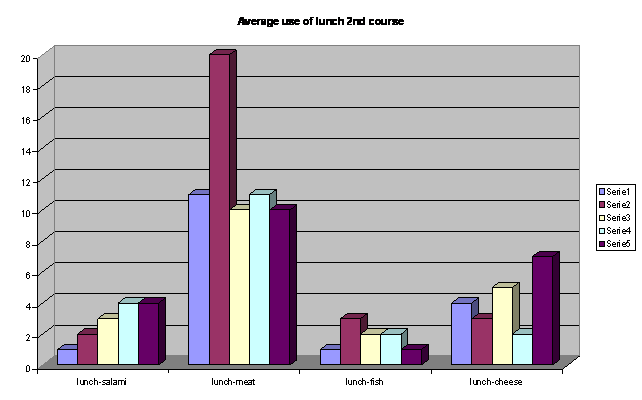
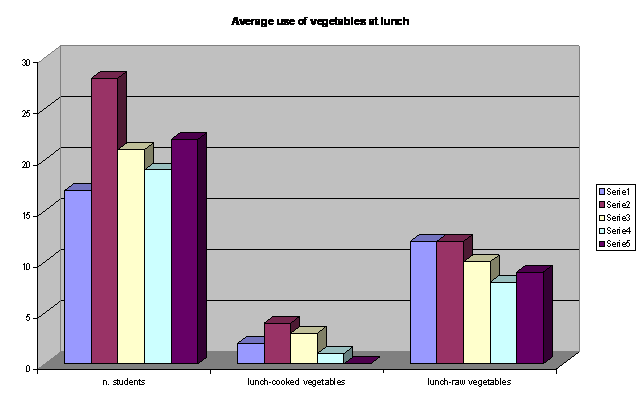
The first course mainly consumed is still pasta, while rice and legumes are not very much popular. Meat is best liked second course followed by cheese and diary products, while the use of salami increases as far as they grow up. Fish is in the last position, according to the group’s expectations, and together with the consume of traditional Mediterranean legumes, this is another datum to work about and develop a new awareness of healthy food. The most astonishing result is about vegetables. Have a look at the picture and you’ll realize that there’s a percentage not eating vegetables at all, and the ones who do, prefer raw to cooked ones. Here again the expectations of the group were right. Young do not like vegetables very much. The use of fruit and sweets at lunch was also investigated 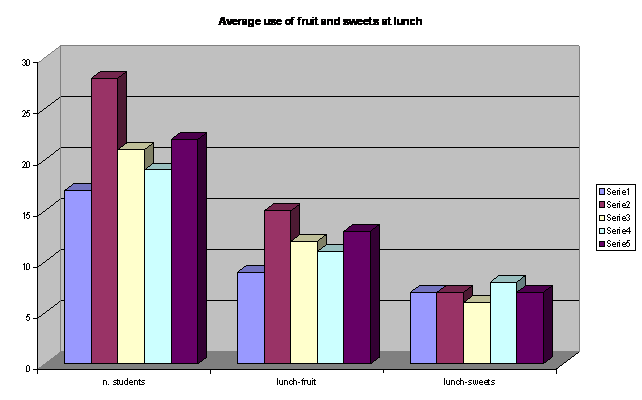
and considering the total number of the sample, fruit is still present at lunch. The group also inserted the chance to consume lunch in an alternative way to the traditional one: 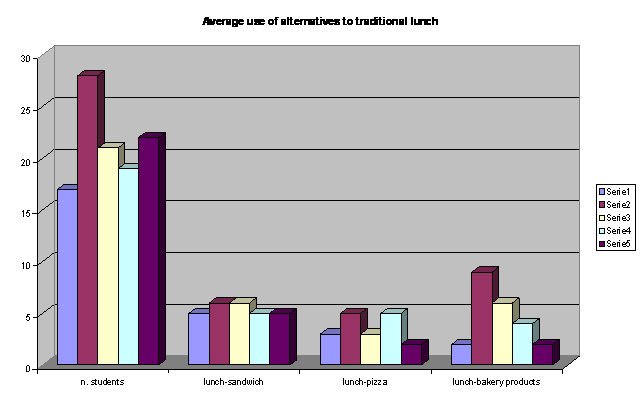
Out of the total number of young interviewed, there is a percentage having an alternative lunch with respect to the traditional one, above all when they are not at home (they stay in school for extra-courses, they go for sports activities, ect.). It has been noticed that the best liked products used in this area are sandwiches and local bakery products, a sort of traditional Italian fast food (focaccia, panzerotti, taralli and so on). No “global” fast food for lunch, then. This is against our stereotype!! DINNER Dinner habits were investigated re-proposing the same categories used for lunch, starting with second course, vegetables, fruit and sweets, alternatives to traditional dinner. Here you are the results: 
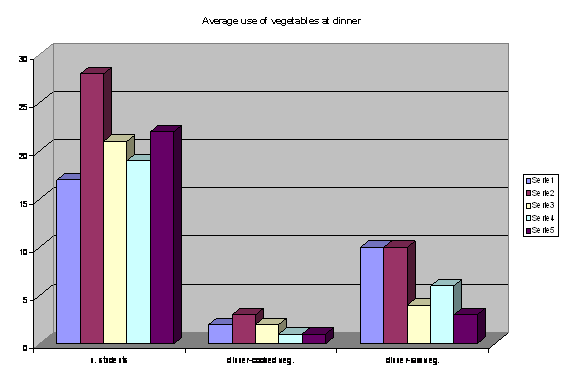
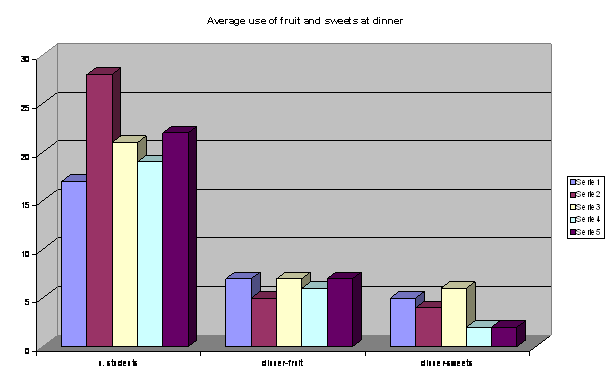
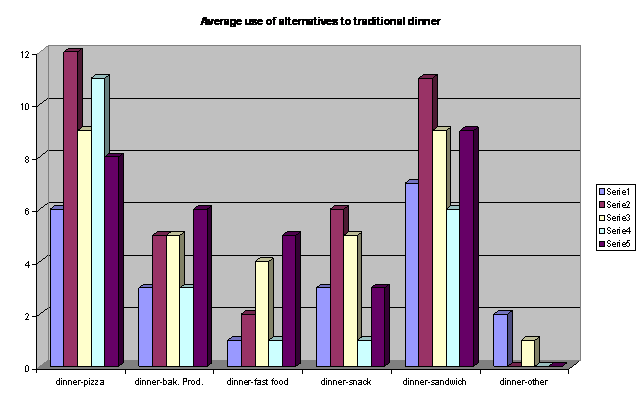
Analysing the results you can easily infer that dinner habits are quite different from the lunch ones. Indeed, while at lunch we have observed that the trend is still towards a traditional kind of diet, at dinner the majority of young prefer alternatives to traditional diet, consuming large amounts of pizza and sandwiches, local bakery products again, and snacks. Second courses are present only as salami and meat used mainly to stuff sandwiches, while vegetables are seldom used, like fruit and fish. Here the voice “other” often includes ice-cream. If you reflect about the data of lunch and dinner together, you’ll realize that the less consumed items among young are fish, vegetables and fruit. Even cheese and diary products (Italian mozzarella and hundreds of traditional cheese) are not very much loved, above all at dinner. There’s a last area to investigate, the habit of eating between the meals, which seem to be very widespread among young people. Let’s see if our sample follows the trend: 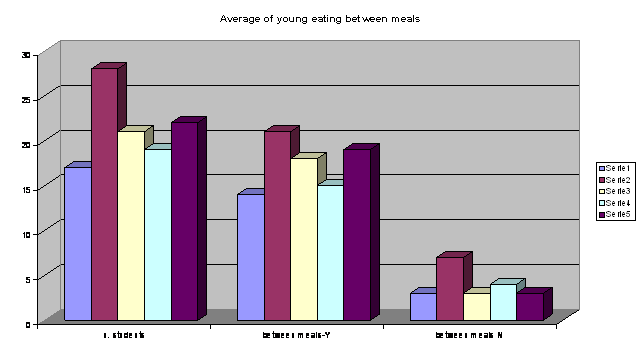
Well, the most part of them eats between the meals, but what? 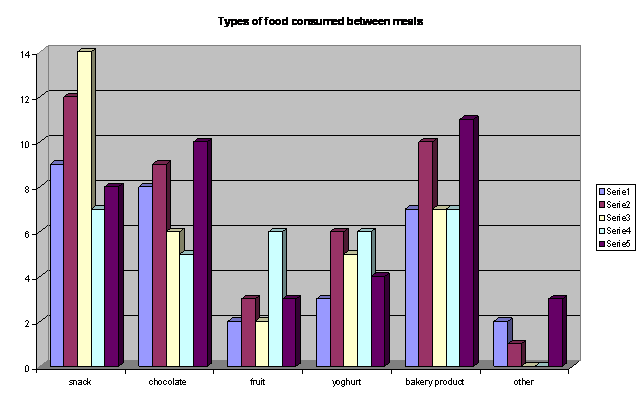
Snacks, bakery products and chocolate are the most popular among them…No surprise! SOCIAL ADVERTISING CAMPAIGN After the survey the group of work decided to create a campaign of social advertising in order to awaken young population to the problem of a healthy diet and positive lifestyles. 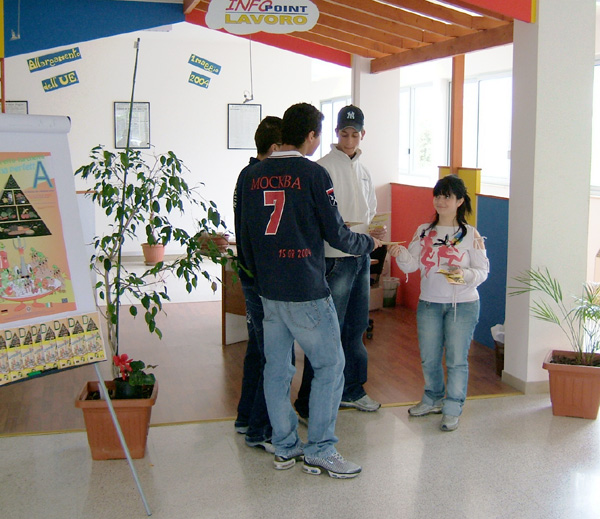
A German magazine “Zeitbild” published a social advertising campaign as a SOCRATES project LINGUA in occasion of the World Football Championship called “StarWatch 2006”. Five European countries are partners of the project, Germany, Nederlands, Italy, Great Britain and Czech republic. They maintain that 14 million of young in the whole Europe suffer from obesity, and the rates are becoming higher and higher, that is why the risk of diseases for these people in later age increases. The World Championship as a big sports event offers the chance to motivate young to commit themselves more for their physical fitness and health. The football stars are good examples for grater physical movement and a healthy diet. In this project 21 international stars offer their personal advice. StarWatch 2006 aims to motivate young to create new projects about health and fitness through a European competition ending with a great festival to be held in Munich next July. (visit the website: www.starwatch2006.net ). The Resource Centre received the materials to be widespread among young, so the group decided to join the European initiative using it in order to intervene in the “weak fields” investigated. 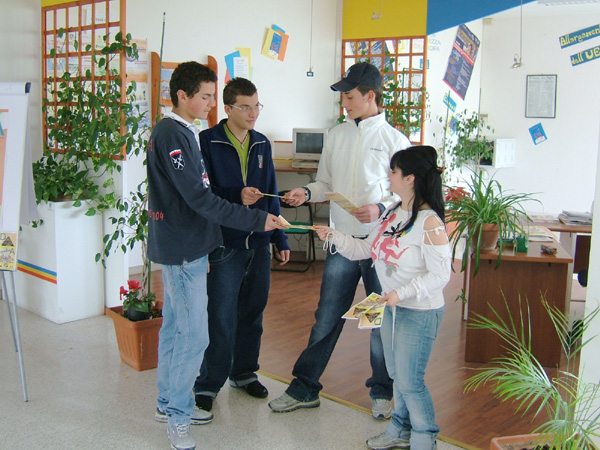
They chose sheets like “Start with a good breakfast”, “Lunch’s ready!”, “Drink right!”, and the “StarWatch Menu” and distributed them among the young population attending the Centre. The StarWatch slogan ”FIT WITH YOUR CHAMP” was also used in the local advertising campaign. Among the students there is a national champion of athletics, so he offered himself to be our local star testimonial and give advice about fitness, and healthy diet to anyone interested. Further, they created a poster, a playbill, a leaflet and a slogan “DA UNA CORRETTA FORCHETTA, LA FORMA PERFETTA” (a correct fork for a perfect form), for the campaign to be held in the Centre. 
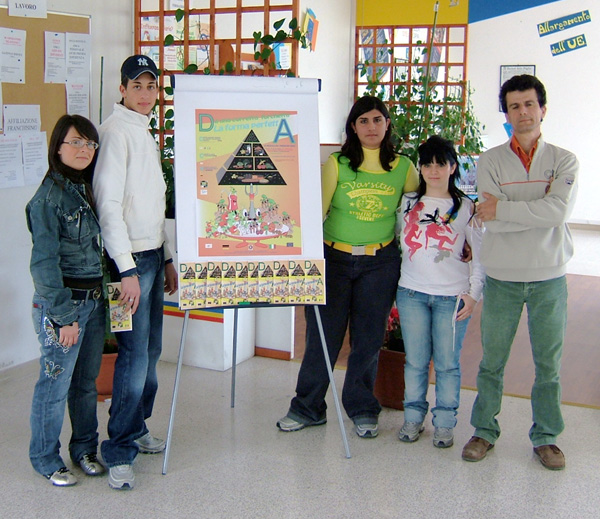
All the materials are in Italian and will be sent to StarWatch to participate the European Competition. An info-point was also prepared to distribute all the materials and give information to young people and to any citizen attending the Centre. Please download: depliant-definitivo english page 1.jpg Please download: depliant-definitivo english page 2 Please download: manifesto definitivo.jpg Please download: young diet and healthy lifestyles.pdf
|
|
|||||||||||||||||||||||||||||||||||


